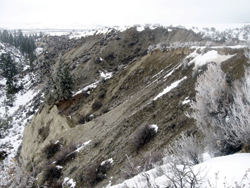
OKANOGAN – The Eagle Canyon Long Plat 2008-8 was continued again until March 23 at 7 p.m. during its second hearing with the Okanogan Planning Commission on Monday, Feb. 23.
The hearing began with Perry Huston, Director of Planning and Development, reporting to the planning commission that the State Environmental Protection Act (SEPA) appeal against the development had been denied.
“I want the public to understand the SEPA is a uniform review process for all projects as a consistent and baseline guideline for projects,” Huston said. “The appeal period has not expired and my recommendation is to continue this hearing for another month to allow that period to expire and to go over all of the information in this development.”
Ben Rough, senior planner, then gave a brief overview of the project to the commission.
“Originally, it was a six-phase long plat on 325 acres with 112 lots,” Rough said. “The average density was approximately 2.9 acres per lot. The proponents have modified the proposal.”
The proponents, Tonasket Homesteading LLC, modified their original proposal so that it is now 88 lots with an average density of 3.7 acres per lot.
Tim Verbeck Sibley, of Tonasket Homesteading LLC, then spoke to the planning commission. He began with a quick introduction which included the fact that he was born and raised in Okanogan County, living most of his life in Tonasket and Oroville. He stated that although he’s lived in California for the last two years, he visits the area a few weeks a year and has also owned two small rental homes in Oroville for the past few years. He then addressed his proposal.
“Despite what we all read about the nation as a whole and America’s housing industry, Okanogan County and the Tonasket area itself keeps right on growing,” Verbeck Sibley said. “Most of the builders we’ve talked with around Tonasket are booked into 2010 already and I know of people who are right now planning to build a house near Tonasket and have had difficulty finding someone to do the building this year. Growth has hardly slowed here.”
He added that with growth, comes legitimate concerns about resources, such as water and farmland, environmental habitat and aesthetics like views and housing styles.
“I’ve worked closely with my father, Ron, for the last two years to come up with a proposed structure to responsibly handle a portion of the growth that the area is experiencing right now,” Verbeck Sibley said.
He then clarified for the public what exactly this development is.
“This is a land development. We’re not building houses, rather we’re proposing to put in infrastructure: the roads, the utilities, the water supply, the rules via a homeowners’ association, so that people can purchase lots and create their own homes,” he said. “These lots are all between one and 5.5 acres; most are right around two acres. If the project goes through all of its phases over the next 10 to 20 years, it could include up to 88 lots. The first phase we are seeking final approval for now contains 22 lots.”
He then compared this project with Crumbaucker, to provided an example of what Tonasket Homesteading is planning to do in order to help the public visualize the project.
“In this project, each lot will be a little larger and more spread out than in Crumbaucker and the nature of the land makes these lots available as small farms where people might own a horse or grow one or a few acres of a crop,” he said. “But the overall concept is the same; this is a land development that might take place over many years – as people move into this area and seek places to build their own home, this is one place where they will be able to do that within the rules set forth by this development agreement.”
Finally, Verbeck Sibley addressed the concerns regarding the Tonasket Airport.
“We’ve made modifications to the project in response to comments by the Department of Transportation and the City of Tonasket,” he said. “For both the airport and for the fact that there are neighboring farms and that residents of this development will themselves farm, every purchaser of lots in this development will sign agreements that they recognize the current and future rights of the airport, that planes fly overhead and the right of everyone in the area to farm and engage in all farming activities.”
Verbeck Sibley’s father, Ron Verbeck, then spoke regarding the amount of available water in the area Tonasket Homesteading wishes to develop.
“Under this land is the largest underground aquifer I have ever worked with,” Verbeck said. “The water is drawn from large irrigation wells and has been pumped continuously each irrigation season for many years. When the wells were developed, observation wells were monitored and draw-down tests were performed. These wells do not draw from the Okanogan River alluvium and do not affect the wells in West Tonasket. These wells are monitored by the Washington State Department of Ecology. The wells are metered and weekly readings are taken for both rate of flow and total volume of water withdrawn. An irrigation company operates the wells and protects the water rights. This irrigation water will be used by future homeowners for irrigation.”
He added that eight domestic wells to provide domestic water will be dug by Tonasket Homesteading. He said the maximum amount of water that can be withdrawn from these wells is only 6.5 percent of the total amount that is currently being used to irrigate the property.
Verbeck then addressed the cherry orchard which will be surrounded by one phase of the development.
“The cherry orchard is not a problem,” he said. “It is an organic orchard, so they have to have a 25 foot clear zone with their own fence. In addition, we have placed the road in phase three around the orchard, so that there will be easy access to the orchard and a 60 foot right of way as additional distance between the orchard and surrounding lots. Throughout the valley there are residential homes right next to farms and this development will encourage that same spirit of cooperation.”
Planning Commission Chairman Albert Roberts then reopened the public comment time from last month, allotting every person who wished to speak five minutes in which to do so. He added that unlimited written comments can be submitted as well and that this will not be the final comment period because the hearing is going to be continued to next month.
Most of the public comments restated concerns already voiced: about a lack of water supply in the area and the fire hazard of such a large development. One new concern that came up was the amount of sand and clay in the area which has caved-in in the past, taking the life of a young boy in 1981. Many of the people speaking expressed concerns over the sand and clay in the area of this proposed development.
However, some people at the hearing expressed approval of this proposal.
“I’ve been involved as a land developer for 20 years and I’m in favor of this development,” Jerry Jensen said. “They’ve been very careful and diligent in planning and I’m excited about the development. I think it’s answering to the growth that Tonasket is going to see whether we want it to or not.”
M
artin Pitney, an agricultural consultant from Richland and one of the owners of Pine Creek Orchard, LLC said that all of the construction on the wells has been completed and the water right is in good standing.
“I can assure you there is enough water to support all phases of this development,” he added.
Once everyone present had gotten the opportunity to speak, the planning commission once again stated that the hearing will be continued for one more month, until Monday, March 23 at 7 p.m.





